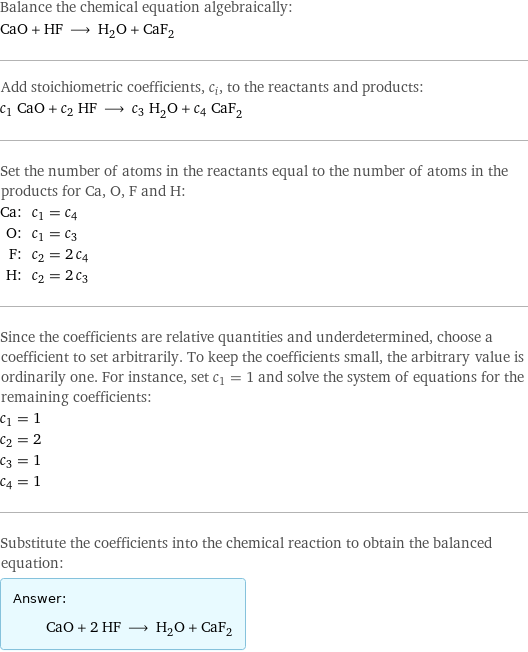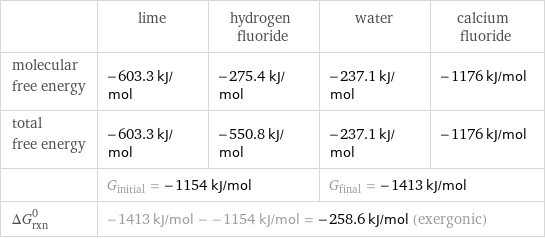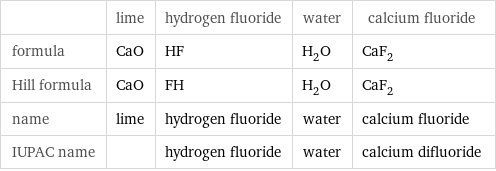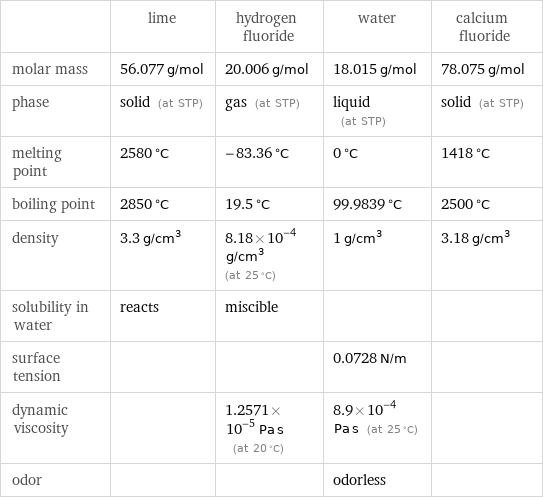Input interpretation

CaO lime + HF hydrogen fluoride ⟶ H_2O water + CaF_2 calcium fluoride
Balanced equation

Balance the chemical equation algebraically: CaO + HF ⟶ H_2O + CaF_2 Add stoichiometric coefficients, c_i, to the reactants and products: c_1 CaO + c_2 HF ⟶ c_3 H_2O + c_4 CaF_2 Set the number of atoms in the reactants equal to the number of atoms in the products for Ca, O, F and H: Ca: | c_1 = c_4 O: | c_1 = c_3 F: | c_2 = 2 c_4 H: | c_2 = 2 c_3 Since the coefficients are relative quantities and underdetermined, choose a coefficient to set arbitrarily. To keep the coefficients small, the arbitrary value is ordinarily one. For instance, set c_1 = 1 and solve the system of equations for the remaining coefficients: c_1 = 1 c_2 = 2 c_3 = 1 c_4 = 1 Substitute the coefficients into the chemical reaction to obtain the balanced equation: Answer: | | CaO + 2 HF ⟶ H_2O + CaF_2
Structures

+ ⟶ +
Names

lime + hydrogen fluoride ⟶ water + calcium fluoride
Reaction thermodynamics
Enthalpy

| lime | hydrogen fluoride | water | calcium fluoride molecular enthalpy | -634.9 kJ/mol | -273.3 kJ/mol | -285.8 kJ/mol | -1228 kJ/mol total enthalpy | -634.9 kJ/mol | -546.6 kJ/mol | -285.8 kJ/mol | -1228 kJ/mol | H_initial = -1182 kJ/mol | | H_final = -1514 kJ/mol | ΔH_rxn^0 | -1514 kJ/mol - -1182 kJ/mol = -332.3 kJ/mol (exothermic) | | |
Gibbs free energy

| lime | hydrogen fluoride | water | calcium fluoride molecular free energy | -603.3 kJ/mol | -275.4 kJ/mol | -237.1 kJ/mol | -1176 kJ/mol total free energy | -603.3 kJ/mol | -550.8 kJ/mol | -237.1 kJ/mol | -1176 kJ/mol | G_initial = -1154 kJ/mol | | G_final = -1413 kJ/mol | ΔG_rxn^0 | -1413 kJ/mol - -1154 kJ/mol = -258.6 kJ/mol (exergonic) | | |
Equilibrium constant
![Construct the equilibrium constant, K, expression for: CaO + HF ⟶ H_2O + CaF_2 Plan: • Balance the chemical equation. • Determine the stoichiometric numbers. • Assemble the activity expression for each chemical species. • Use the activity expressions to build the equilibrium constant expression. Write the balanced chemical equation: CaO + 2 HF ⟶ H_2O + CaF_2 Assign stoichiometric numbers, ν_i, using the stoichiometric coefficients, c_i, from the balanced chemical equation in the following manner: ν_i = -c_i for reactants and ν_i = c_i for products: chemical species | c_i | ν_i CaO | 1 | -1 HF | 2 | -2 H_2O | 1 | 1 CaF_2 | 1 | 1 Assemble the activity expressions accounting for the state of matter and ν_i: chemical species | c_i | ν_i | activity expression CaO | 1 | -1 | ([CaO])^(-1) HF | 2 | -2 | ([HF])^(-2) H_2O | 1 | 1 | [H2O] CaF_2 | 1 | 1 | [CaF2] The equilibrium constant symbol in the concentration basis is: K_c Mulitply the activity expressions to arrive at the K_c expression: Answer: | | K_c = ([CaO])^(-1) ([HF])^(-2) [H2O] [CaF2] = ([H2O] [CaF2])/([CaO] ([HF])^2)](../image_source/0687e9f9febc8589a8dfe1ef61a7000f.png)
Construct the equilibrium constant, K, expression for: CaO + HF ⟶ H_2O + CaF_2 Plan: • Balance the chemical equation. • Determine the stoichiometric numbers. • Assemble the activity expression for each chemical species. • Use the activity expressions to build the equilibrium constant expression. Write the balanced chemical equation: CaO + 2 HF ⟶ H_2O + CaF_2 Assign stoichiometric numbers, ν_i, using the stoichiometric coefficients, c_i, from the balanced chemical equation in the following manner: ν_i = -c_i for reactants and ν_i = c_i for products: chemical species | c_i | ν_i CaO | 1 | -1 HF | 2 | -2 H_2O | 1 | 1 CaF_2 | 1 | 1 Assemble the activity expressions accounting for the state of matter and ν_i: chemical species | c_i | ν_i | activity expression CaO | 1 | -1 | ([CaO])^(-1) HF | 2 | -2 | ([HF])^(-2) H_2O | 1 | 1 | [H2O] CaF_2 | 1 | 1 | [CaF2] The equilibrium constant symbol in the concentration basis is: K_c Mulitply the activity expressions to arrive at the K_c expression: Answer: | | K_c = ([CaO])^(-1) ([HF])^(-2) [H2O] [CaF2] = ([H2O] [CaF2])/([CaO] ([HF])^2)
Rate of reaction
![Construct the rate of reaction expression for: CaO + HF ⟶ H_2O + CaF_2 Plan: • Balance the chemical equation. • Determine the stoichiometric numbers. • Assemble the rate term for each chemical species. • Write the rate of reaction expression. Write the balanced chemical equation: CaO + 2 HF ⟶ H_2O + CaF_2 Assign stoichiometric numbers, ν_i, using the stoichiometric coefficients, c_i, from the balanced chemical equation in the following manner: ν_i = -c_i for reactants and ν_i = c_i for products: chemical species | c_i | ν_i CaO | 1 | -1 HF | 2 | -2 H_2O | 1 | 1 CaF_2 | 1 | 1 The rate term for each chemical species, B_i, is 1/ν_i(Δ[B_i])/(Δt) where [B_i] is the amount concentration and t is time: chemical species | c_i | ν_i | rate term CaO | 1 | -1 | -(Δ[CaO])/(Δt) HF | 2 | -2 | -1/2 (Δ[HF])/(Δt) H_2O | 1 | 1 | (Δ[H2O])/(Δt) CaF_2 | 1 | 1 | (Δ[CaF2])/(Δt) (for infinitesimal rate of change, replace Δ with d) Set the rate terms equal to each other to arrive at the rate expression: Answer: | | rate = -(Δ[CaO])/(Δt) = -1/2 (Δ[HF])/(Δt) = (Δ[H2O])/(Δt) = (Δ[CaF2])/(Δt) (assuming constant volume and no accumulation of intermediates or side products)](../image_source/d668d5167fb3a794e27cc4d1be9a8172.png)
Construct the rate of reaction expression for: CaO + HF ⟶ H_2O + CaF_2 Plan: • Balance the chemical equation. • Determine the stoichiometric numbers. • Assemble the rate term for each chemical species. • Write the rate of reaction expression. Write the balanced chemical equation: CaO + 2 HF ⟶ H_2O + CaF_2 Assign stoichiometric numbers, ν_i, using the stoichiometric coefficients, c_i, from the balanced chemical equation in the following manner: ν_i = -c_i for reactants and ν_i = c_i for products: chemical species | c_i | ν_i CaO | 1 | -1 HF | 2 | -2 H_2O | 1 | 1 CaF_2 | 1 | 1 The rate term for each chemical species, B_i, is 1/ν_i(Δ[B_i])/(Δt) where [B_i] is the amount concentration and t is time: chemical species | c_i | ν_i | rate term CaO | 1 | -1 | -(Δ[CaO])/(Δt) HF | 2 | -2 | -1/2 (Δ[HF])/(Δt) H_2O | 1 | 1 | (Δ[H2O])/(Δt) CaF_2 | 1 | 1 | (Δ[CaF2])/(Δt) (for infinitesimal rate of change, replace Δ with d) Set the rate terms equal to each other to arrive at the rate expression: Answer: | | rate = -(Δ[CaO])/(Δt) = -1/2 (Δ[HF])/(Δt) = (Δ[H2O])/(Δt) = (Δ[CaF2])/(Δt) (assuming constant volume and no accumulation of intermediates or side products)
Chemical names and formulas

| lime | hydrogen fluoride | water | calcium fluoride formula | CaO | HF | H_2O | CaF_2 Hill formula | CaO | FH | H_2O | CaF_2 name | lime | hydrogen fluoride | water | calcium fluoride IUPAC name | | hydrogen fluoride | water | calcium difluoride
Substance properties

| lime | hydrogen fluoride | water | calcium fluoride molar mass | 56.077 g/mol | 20.006 g/mol | 18.015 g/mol | 78.075 g/mol phase | solid (at STP) | gas (at STP) | liquid (at STP) | solid (at STP) melting point | 2580 °C | -83.36 °C | 0 °C | 1418 °C boiling point | 2850 °C | 19.5 °C | 99.9839 °C | 2500 °C density | 3.3 g/cm^3 | 8.18×10^-4 g/cm^3 (at 25 °C) | 1 g/cm^3 | 3.18 g/cm^3 solubility in water | reacts | miscible | | surface tension | | | 0.0728 N/m | dynamic viscosity | | 1.2571×10^-5 Pa s (at 20 °C) | 8.9×10^-4 Pa s (at 25 °C) | odor | | | odorless |
Units
